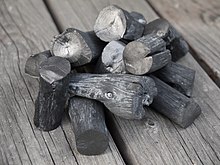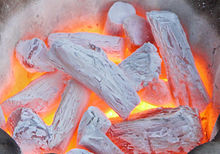Binchōtan


Binchō-tan (Japanese: 備長炭), also called white charcoal or binchō-zumi, is a type of charcoal traditionally used in Japanese cooking. Its use dates to the Edo period, when during the Genroku era, a craftsman named Bichū-ya Chōzaemon (備中屋 長左衛門) began to produce it in Tanabe, Wakayama. The raw material is oak, specifically ubame oak (Quercus phillyraeoides), now the official tree of Wakayama Prefecture. Wakayama continues to be a major producer of high-quality charcoal, with the town of Minabe, Wakayama producing more binchō-tan than any other town in Japan. Binchōtan is a type of lump charcoal or hardwood charcoal.
The fineness and high quality of binchō-tan are attributed to steaming at high temperatures (about 1000 degrees Celsius). Because it does not release unpleasant odours, it is a favorite of unagi (freshwater eel) and yakitori (skewered chicken) cooks. Due to difficulties in identifying the producing region, the name binchō-tan has come into broader use to designate white charcoal generally, and even products from outside Japan, as well as those made of other species, have come to use the name.
To differentiate the aforementioned "non-pure" products, there is a movement to call binchō-tan produced in Wakayama Kishū binchō-tan (紀州備長炭), Kishū being the old name of Wakayama.
Binchō-tan is harder than black charcoal, and rings with a metallic sound when struck. Wind chimes and a musical instrument, the tankin ("charcoal-xylophone") have been made from it.
References
External links
- 紀州備長炭 —Making of Kishū Binchōtan by Wakayama Pref.
- 炭琴 —Tankin ("charcoal-xylophone")
- "Charcoal Adds to the Good Life" – an article from 2001 touting the benefits of black and white charcoal, the latter including binchōtan
